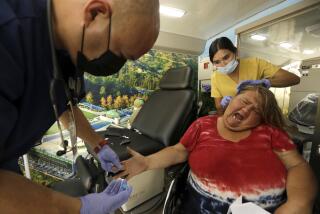Sadly, leprosy’s stigma endures
- Share via
Olav Bjorgass threw an arm around the cook and beamed into my camera. Then the cook returned to chopping vegetables, and the Norwegian doctor showed me the rest of his clinic.
The year was 1983, the place a leprosy hospital in Taiwan. I was a tropical medicine specialist still wet behind the ears. Since then, I have shared my snapshot with many students and colleagues in L.A. Why? For one thing, it tells a chilling tale. With his missing nose and ears, the cook is a textbook case of leprosy halted too late.
For another, most healthcare workers in Los Angeles have never seen a patient with leprosy. The slide reminds them that 1 million to 3 million people in the world harbor the slow, destructive infection, several hundred in our own city.
And I like my photo for what it doesn’t show: the stigma often surrounding leprosy. I’m sure my mentor never dreamed that his embrace would be screened time and again, far away. But did he consciously touch the disfigured cook? I believe he did. Bjorgass was not just a leprosy healer, he was a stigma-warrior.
The history of Mycobacterium leprae attests to the poisonous power of stigma. For centuries before the minimally contagious (and today, fully treatable) microbe was described, leprosy sufferers endured ignominies and ostracism. Then came an era of incarceration in leper colonies, now thankfully past. Even today, despite modern care, a legacy of fear, shame and misinformation dogs certain leprosy victims. In parts of India and Asia, many are convinced their infection cannot be cured, or is a curse from God. As a result, early signs are often hidden or denied. Left untreated, irreversible damage can result: mutilated limbs, sightless eyes.
Leprosy’s toll is perpetuated not just by ignorance but in some regions by the fear that to receive treatment is to “out” oneself. One drug taken by leprosy sufferers darkens skin lesions, making them more conspicuous. Another turns urine a telltale orange. Steroids, given for leprosy-induced nerve injury, create puffy faces, skinny limbs and bulging waistlines. In regions where leprosy is familiar, these are signposts of the disease.
When you think about it, similar trade-offs occur with other stigmatized diseases. Anti-psychotics can induce involuntary muscle movements. Certain HIV drugs cause sunken cheeks, instantly recognizable to well-schooled eyes.
A final byproduct of stigma can be a profound loss of self-worth. In Boston 25 years ago, I learned this from an unforgettable patient, a native of the Azores. His nerve damage was so severe he could hold his hands in a fire and count to 10, a stunt he performed for neighborhood children. His fingers were nubs. Yes, he came to the clinic and took his drugs, but I realized we had failed to meet his deepest need: a love of self.
My most recent Los Angeles leprosy patient was a Spanish-speaking man in his 30s whose arms and back were carpeted in small, purplish plaques. I scheduled a skin biopsy that confirmed his diagnosis. Two weeks later, my patient’s wife translated the findings, and his eyes showed a flicker of hope. But then it faded away.
Please, I begged, as I wrote prescriptions for his starting drugs, come back next week, or better, let me refer you to the L.A. County-USC Hansen’s Disease Clinic. Their doctors are world-famous, their care is free. This disease can be cured.
A week later, when I tried to contact the patient, a stranger answered his phone. The patient never returned and, as far as I know, never went downtown either. Looking back, I wonder if he was an illegal immigrant, and if that tipped the balance between taking treatment and going underground.
I still ask, what should I have done differently? What would Dr. Bjorgass have done?
--
Claire Panosian Dunavan is co-founder of the Program in Global Health at UCLA.






